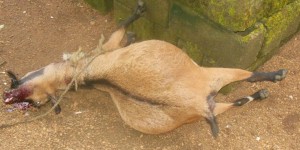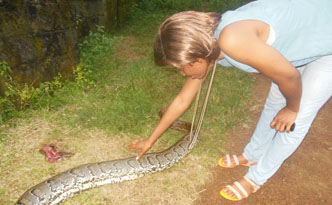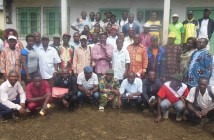Since January 2014, EGI’s community and gender officer Mobia Ruth Njambe has been out to mobilize villagers and inform them of the Chester Zoo funded project. While on her mission, an incident occurred that put her right in the middle of a human-wildlife conflict. Although this time the species was not endangered, it is clear that when it boils down to it, the community members will do what they need to protect themselves and their livelihoods. In this post, she holds a conversation with our communications and public relations trainee Ashu Helen about her experience.
Helen: Tell me about the activities you have been carrying out in Eyumojock?
Ruth: Since January 2014, I have been going around to introduce villagers to EGI’s new project on reducing human-wildlife conflicts. The project is supposed to reduce hunting and trade in bush meat and help people to adopt alternative income activities. EGI noticed that many wildlife species in these areas could get extinct if people keep hunting them. This project will teach the community members about these endangered species.
Helen: During one of your visits, you were party to an incident between the people and a python. Tell me about it.
Ruth: Villagers who rear goats take them out to graze every morning. On that fateful day, one of the boys in the family that was hosting me went to graze the goats. They had five goats. He tied them in different areas in a bushy area near their house.
After my meetings with groups I came back to their house in the evening. It was about time for him to untie the goats. Among the goats was a she-goat that had given birth to two kids a few days earlier. The boy decided to untie her first, but on getting to the place he had tied her, he found that she, along with one of her kids were dead.

To his amazement, he saw a mighty python quite close to him, struggling to kill another goat. When it saw him, the snake slithered away from the goat, hid and stayed very calm. The boy ran back to the house, took a machete and went straight to the scene to fight with the python. He did not inform any of us what he was up to. The next thing I saw was him coming back, dragging a very large python to the house. He dropped the snake, whose head he had almost completely chopped off, to the ground and went back to collect his father’s dead goats.
Helen: How did this make you feel?
Ruth: My first thought was of the many young children in that compound, who always play in the long grass around their home. I thought for a moment, what if this python had killed a child instead of the goats? This thought really frightened me. From what I know, a python takes more than fifteen minutes to hit its target, I wondered if this did not make children vulnerable, because they have a tendency of playing on a particular spot for a very long time.
On the other hand, I was mesmerized to see a python of that size, close up for the first time. I know the area has so many of them, but it was my first time to see one, much more the pity that it was in the last throes of its life when I saw it.
Helen: What happened after the python was killed?
Ruth: Just like in other cultures that I know in that area, after a snake is killed and brought to the house, the villagers take over. Elders and youths of the village came in the morning, operated it, and threw the venom into the toilet. They then shared it among themselves, giving the head to the family of the boy who killed the snake. This collective disposal is a must. In the past, many people had poisoned their foes using the venom, so a traditional norm evolved in the community instructing everyone who killed a python to alert the community so that they can monitor and ensure no one takes any of the venom.
Helen: Is it common for wildlife to attack humans, domestic animals and crops in Eyumojock?
Ruth: Apart from incidents with pythons, sometimes people’s crops are usually destroyed. Also, humans pose a lot of threat to wildlife since hunting is one of the major occupations of the people. Moreover, during my sensitization I visited most of the chiefs and elders of the community. When I got there, I always saw animal skulls like that of monkeys, dear, antelope, chimpanzee etc which are evident of wildlife that has been killed by humans. When I talked to some of the villagers, they confined to me that some organizations had started teaching them about endangered animals and one of them even posted sign boards indicating that there should be no hunting of endangered species.
Helen: So how has this incident and your visits influenced your project plans?
Ruth: I think the community can easily control snake populations around their surroundings by clearing the areas and using substances that repel them. As for their hunting habits, I really think it is time for them to revisit their rate of hunting which animals they capture. During this incident, I realized that the people in Ajayukndip and other villages in Eyumojock are not so concerned about the things we talk about like endangered species or saving wildlife. Their first instinct is survival, protecting and feeding their families. I am more convinced now that we need to hold more meetings to talk about the interdependence between them and the wildlife in the area. I strongly feel that only continuous engagement with local populations will lead to a change in their knowledge base and their attitudes towards wildlife.



